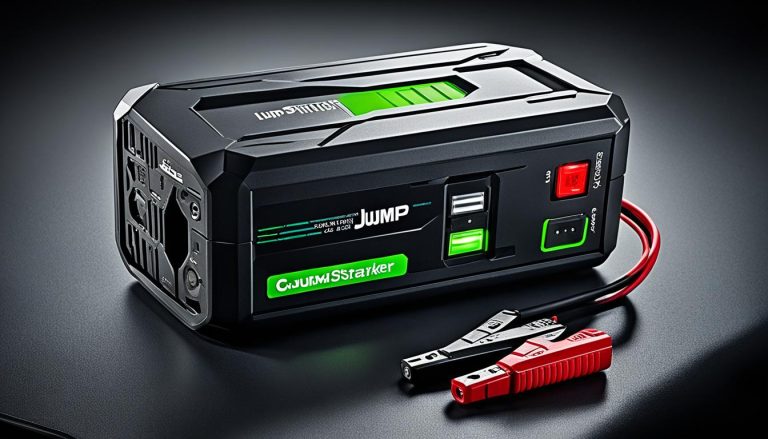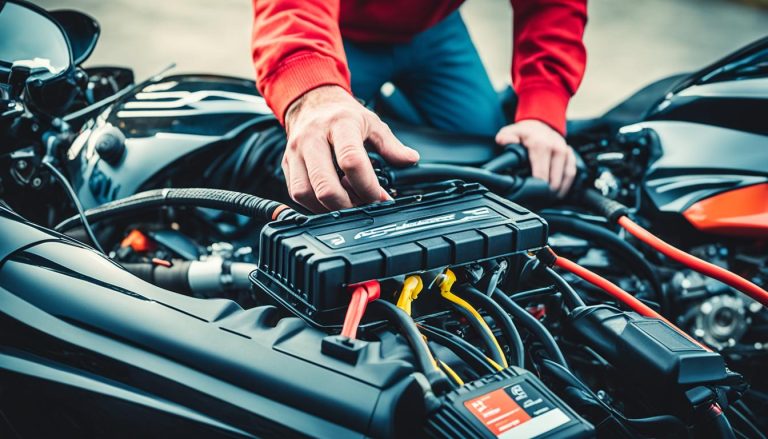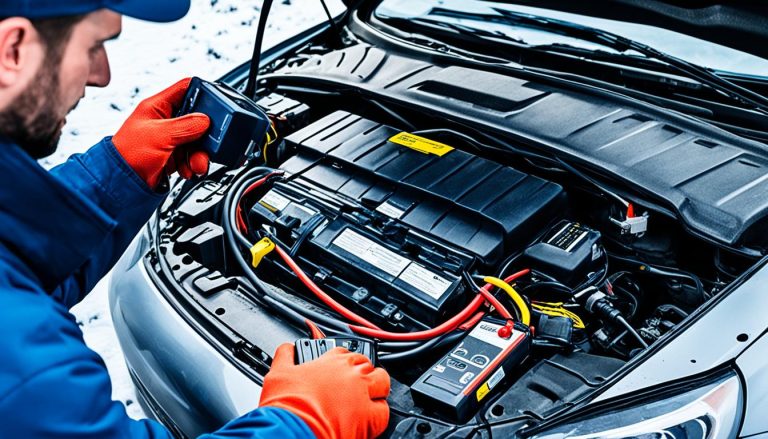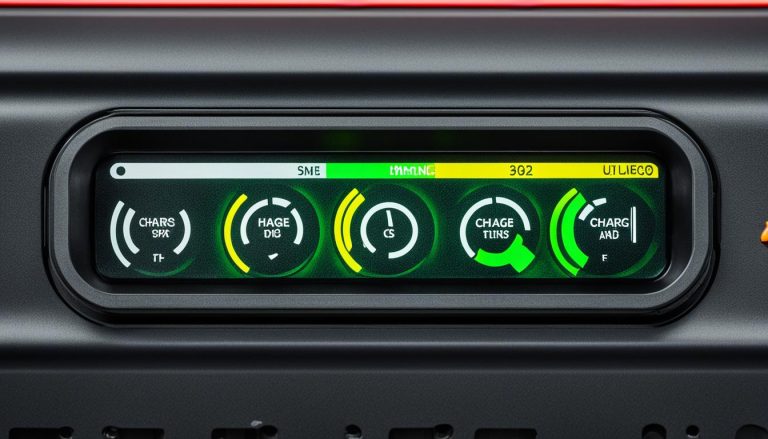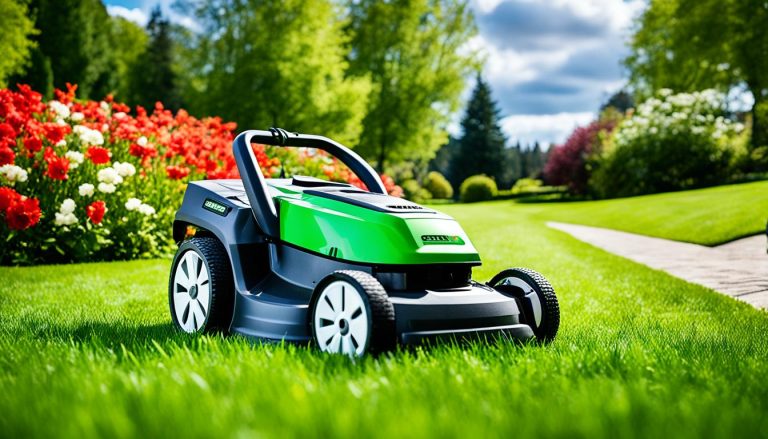Jump Start Your Car with a Battery Pack Easily
batterychargers.site and its partners may earn a commission if you purchase a product through one of our links
When you’re faced with the all-too-common dilemma of a car that won’t start, knowing how to jump start a car with a battery pack can be a lifesaver. Picture this: You’re running late, you turn the key, and all you get is a dreaded click. No need to stress—help is at hand. With the right portable car battery jump starter, you can breathe life back into your vehicle and be on your way in no time. Forget the old days of needing another car for a jump; today’s technology puts the power right in your trunk.
Whether you’re on a city street or a country road, a reliable car battery jump start using a battery pack is a straightforward procedure that can get you moving quickly. It’s all about having the right gear and following a few simple steps to ensure your safety and protect your vehicle from damage. So, let’s get right into it and make sure you’re prepared for those unexpected moments when your car battery decides to take an unscheduled nap.
Key Takeaways
- Understand the simple process of using a portable battery pack to jump start your vehicle.
- Familiarize yourself with the safety measures to avoid injury or damage to your car’s electrical system.
- Discover the convenience and ease-of-use that modern battery packs bring to car battery jump starts.
- Prepare for unexpected battery failures by keeping a charged jump starter in your vehicle.
- Gain the peace of mind that comes from being self-reliant in jump-starting your car.
- Learn the importance of post-jump procedures to ensure your car battery and jump starter are properly maintained.
Understanding the Basics of Car Batteries and Jump Starting
Embarking on a journey of car maintenance requires understanding the heart of your vehicle – the battery. With this knowledge, you’re equipped to tackle sudden automotive hurdles like a drained battery, even without traditional tools like jumper cables. A battery pack jump start can be your savior in such situations, ensuring you’re back on the road in no time.
Recognizing the Signs of a Dead Battery
A dead battery can disrupt your day without warning. It’s important to recognize the early signs before you’re left stranded. Dimmed headlights and interior lights, the infamous clicking sound when turning the key, and sluggish engine cranks are common distress signals. The electronic components in your car fail to perform, pointing towards the need for a battery pack jump start. Remember, such symptoms often occur from energy-intensive mistakes, like leaving lights on when the car is off.
How Portable Jump Starters Work
Unlike jumper cables that require a donor vehicle, a car battery jump pack acts as a standalone rescuer. These portable jump starters store energy to provide the immediate burst of power needed to revive your vehicle’s slumbering engine. Upon successful ignition, your car’s alternator kicks in, recharging the battery to breathing life back into your automobile’s system. These handy devices are a must-have accessory for any driver, epitomizing convenience in jump starting a car without jumper cables.
Advantages of Using a Portable Jump Starter:
- Independence from a second vehicle
- Quick, efficient power delivery
- Compact and easy-to-store
- Multi-functional with additional charging ports for devices
Safety Precautions Before Jump Starting Your Car
Safety should never take a backseat when dealing with automotive batteries. Taking the necessary precautions is crucial to prevent accidents during the jump start process. Always wear protective gear, like gloves and safety glasses, and ensure your surroundings are free of any flammable materials. Managing jump leads correctly is vital too – improper handling can result in dangerous sparks, potentially igniting battery gases.
| Action | Reason |
|---|---|
| Wear protective gear | To shield from electric shock and battery acid |
| Remove any nearby flammable objects | To prevent fire hazards during the jump start process |
| Follow the correct sequence when attaching leads | To ensure a safe and successful jump start |
In summary, knowing the condition of your car battery and the functionality of battery pack jump starters empowers you to confront the challenge head-on. Be sure to follow the proper safety guidelines to use your car battery jump pack effectively and keep your driving adventures uninterrupted.
Choosing the Right Portable Jump Starter
When you find yourself with a car that won’t start, knowing how to use a car battery jump starter can be a game-changer. Modern drivers are turning to convenient solutions, such as portable battery packs, for a quick and hassle-free jump start. But with so many options on the market, what should you look for?
Key Features to Look for in a Battery Pack
In your quest for the perfect portable jump starter, consider the variety of features they can offer. For instance, a car battery charger and jump starter with USB connections can keep your devices charged on the go, while models with built-in air compressors come in handy for maintaining tire pressure.
- USB connections for charging mobile devices
- Built-in air compressors for tire maintenance
- Emergency lights for visibility during night-time use
- 12-volt outlets and inverters to power various accessories
- Radios for communication in emergencies
Remember to periodically recharge your battery pack, especially after use, every six months, or before a long journey. These features not only enhance the convenience of jump starting a car with a portable battery pack, but they also contribute to your overall roadside preparedness.
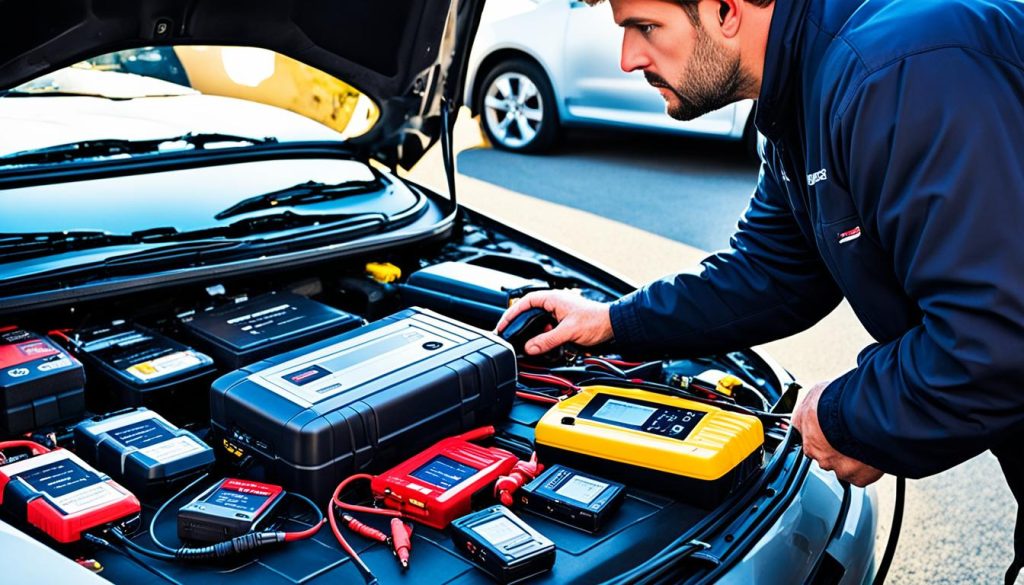
Comparing Battery Chargers and Portable Jump Starters
Understanding the difference between a traditional car battery charger and a portable jump starter is crucial. A dead battery typically presents symptoms like dimming lights and an inability to start the car, which requires immediate attention. Portable jump starters offer a swift solution to this dilemma by instantly supplying the power needed to crank the engine. In contrast, traditional chargers are designed for a slow recharge, often needing several hours to restore a battery’s full capacity.
| Feature | Portable Jump Starter | Traditional Charger |
|---|---|---|
| Charging Time for Car Battery | Instant crank power | Several hours |
| Power Source | Self-contained battery | Requires AC power |
| Additional Features | Multiple (USB ports, air compressor, etc.) | Limited |
| Mobility | High (no cables needed) | Low (must be connected to mains) |
| User Friendliness | Designed for quick and easy use | More complex setup |
| Emergency Readiness | High (ideal for unexpected situations) | Low (requires planning ahead) |
Armed with this knowledge, you can choose the most suitable device for your needs, ensuring that you’re never left stranded with a dead battery. Whether you prioritize speed, versatility, or extra features, there’s a car battery charger and jump starter made just for you.
Preparing to Jump Start Your Vehicle
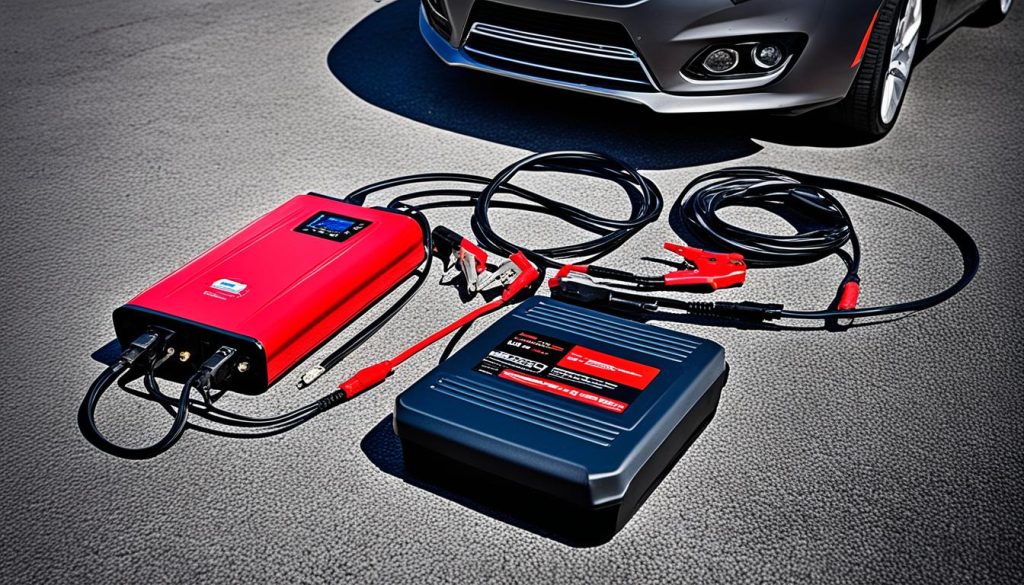
Before you begin the process of jump starting a car with a battery pack, it’s essential to have all your tools and safety gear at hand to ensure a smooth and safe operation. This preparation is the first and foremost step to getting your car back on the road without any mishaps. So, let’s get you ready to harness the power of your portable car battery jump starter.
Gathering Necessary Equipment and Protective Gear
For any successful car battery jump start, you’ll need certain equipment and safety items. Without the proper gear, you risk damaging your vehicle or injuring yourself. Here is a quick checklist to ensure you have everything you might require:
- Fully charged portable battery jump starter
- Insulated gloves
- Safety glasses
- Your car’s manual
Selecting the right jump starter is crucial. Make sure that the amperage is suitable for your vehicle’s engine size. Additionally, it is wise to check that your portable jump starter has enough charge before you begin; it’s a step that is sometimes overlooked but can save you from further frustration.
Locating Your Vehicle’s Battery
Finding the battery in your vehicle is usually straightforward, but it may be hidden beneath plastic covers or disguised in a remote corner of the engine bay. Consult your car’s manual to pinpoint the exact location and understand any manufacturer-specific instructions pertaining to jump starting a car with a battery pack. Remember, some modern vehicles have batteries located in the trunk or beneath the back seat for space or design considerations.
A table summarizing possible battery locations and access tips might look like this:
| Vehicle Type | Battery Location | Access Tips |
|---|---|---|
| Sedan | Engine bay | Remove plastic covers if necessary |
| SUV | Engine bay or under the front passenger seat | May require moving the seat or removing panels |
| Sports Car | Trunk or under the hood in a hidden compartment | Check for release latches or buttons |
| Electric Vehicle (EV) | Under the vehicle floor | Special access points; refer to manual |
Once you’ve located your battery and you’re geared up with your safety equipment, you’re now set to proceed with the jump start process using your portable car battery jump starter. Always remember to remove any jewelry and keep the vehicle’s manual handy for quick reference to avoid any issues with intricate electronic systems.
How to Jump Start a Car with a Battery Pack
When your car won’t start, and you suspect a discharged battery, a battery pack can be a lifeline. Before you begin the jump start process, it’s important to ensure you have a quality car battery jump pack at hand. With the right battery pack jump start method, you can get back on the road quickly and safely. Let’s go through the steps needed to revitalize your vehicle’s battery.
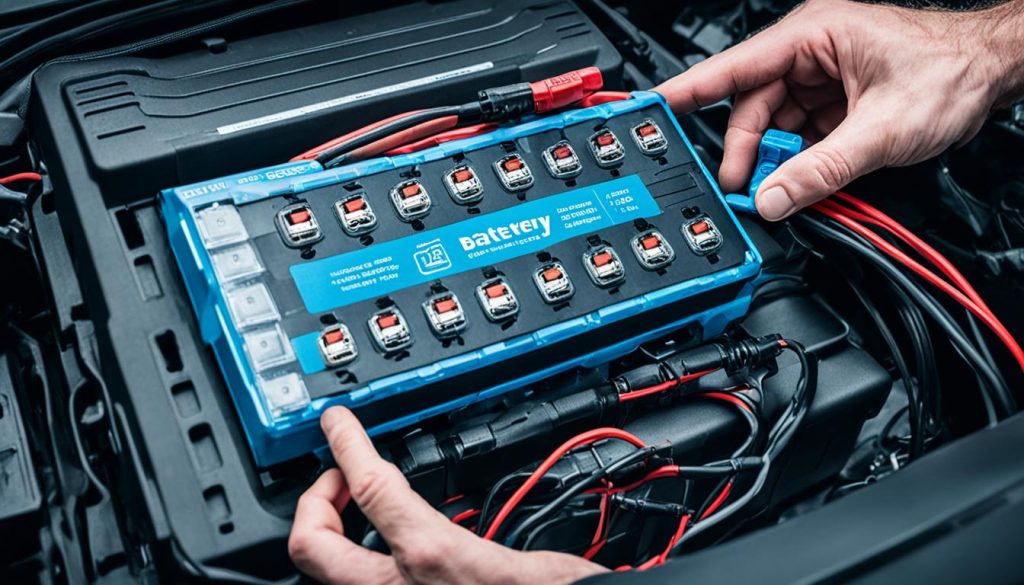
Step-by-Step Connection Guide
The first step in how to jump start a car with a battery pack involves establishing a secure connection. Attach the red clamp from your jump start battery pack to the positive terminal of the car battery; it is almost always marked with a plus (+) sign. Next, find a solid, unpainted metal surface on the engine block to connect the black clamp; this serves as your grounding point. It’s crucial that these connections are secure for the jump start to be effective.
Starting the Car and Removing Cables Safely
Once everything is in place, switch on your car battery jump pack. Try to start your vehicle but remember to crank the engine no more than five seconds at a time to avoid damage. If the car starts—congratulations! Turn off the jump pack before you disconnect the clamps, starting with the black one and then the red one. Once removed, it’s advisable to drive your car for at least 20 minutes to allow the alternator to recharge the battery sufficiently.
| Step | Action | Important Note |
|---|---|---|
| 1 | Attach red clamp to positive battery post | Ensure all electronics are off before connecting |
| 2 | Attach black clamp to grounded metal on engine | Do not attach to battery negative post to avoid sparks |
| 3 | Turn on jump pack | Stand back as a precaution |
| 4 | Attempt to start the car | Crank for no more than 5 seconds |
| 5 | If car starts, turn off jump pack | Remove clamps in reverse order |
| 6 | Drive to recharge battery | Drive or idle the car for at least 20 minutes |
Remember, always consult your car’s manual for any specific instructions or precautions, especially with newer models that have advanced electronic systems. This careful approach will ensure that you can jump start your vehicle without risking any damage to its sophisticated components. Keep your tools handy, and you’ll never be stranded by a dead battery again.
Maintaining Your Car Battery and Jump Starter Post-Jump
After successfully reviving your vehicle with a car battery jump start, the upkeep of both your car battery and the portable jump starter cannot be overstated. The immediate post-jump period is a critical time to reinforce the longevity and effectiveness of your emergency equipment. Think of your portable car battery jump starter as a reliable companion on the road – keeping it charged and ready is paramount for your peace of mind and safety.
Properly Charging Your Portable Jump Starter
How to jump start a car with a battery pack is knowledge well worth having, but maintaining that battery pack is equally important. Your portable jump starter is an investment in your vehicle’s continued operation, so treat it with care. Usually, a full charge can take anywhere from 3 to 24 hours, so planning ahead is crucial. Following each use, adhere to the charging guidelines provided by the manufacturer. Doing so ensures that your jump starter will have sufficient power the next time you need it. Regularly monitor and recharge the device, especially before embarking on any lengthy trips, to avoid being caught off-guard by a drained battery pack.
Driving Tips to Recharge the Car Battery
Once your engine is humming again, it is your car battery’s turn to regain its strength. The best way to jump start this process is by driving your vehicle for a minimum of 30 minutes. This extended period of running allows your car’s alternator to replenish the battery’s charge. If an extended drive isn’t practical immediately after jump starting, a period of idling, although not as effective, can serve as a temporary measure. However, if you find that your battery consistently fails to maintain charge without any apparent cause, it could be wise to have it examined at a local service center to rule out any underlying issues. Vigilance and proper care of your vehicle’s battery and the jump starter will ensure you’re prepared, whether it’s for daily commutes or unexpected adventures.
FAQ
What are the signs that my car battery is dead?
Recognizing a dead battery is essential to diagnose your car’s issues accurately. You may notice that your lights are dimmer than usual, electrical components are not functioning properly, or you hear a clicking noise when the ignition is turned on.
How do portable jump starters work?
Unlike traditional battery chargers that require hours to recharge a battery, portable jump starters quickly provide the necessary cranking power to start your car. After the engine is running, your car’s alternator will recharge the battery as you drive.
What safety precautions should I take before jump starting my car?
Before jump starting your car, it’s crucial to take several safety measures. Wear protective gear like gloves and safety glasses and ensure all devices, including the car and the battery pack, are turned off. Connect the clamps correctly — the red clamp to the positive battery post and the black clamp to an unpainted metal part of the engine block, not the battery’s negative post, to avoid sparks.
What features should I look for in a battery pack?
When selecting a portable jump starter, look for key features that suit your needs: USB connections for charging devices, built-in air compressors, emergency lights, and even extra features like radios or 12-volt outlets can be beneficial depending on your situation.
How are battery chargers different from portable jump starters?
The main difference between battery chargers and portable jump starters is how they operate. Battery chargers require a longer time to fully recharge a battery, while portable jump starters are designed to provide a swift power boost to start a car immediately.
How do I prepare to jump start my vehicle?
To prepare, first ensure your portable jump starter is fully charged. Gather any necessary protective clothing, consult your car’s manual to locate the battery — which is often under the hood but may be in different locations depending on the make and model — and make sure to remove any jewelry to prevent electrical hazards.
What are the steps to jump start a car with a battery pack?
Begin by connecting the positive (red) clip to your car battery’s positive post. Connect the negative (black) clip to a grounded, unpainted engine part. Turn on the jump pack, start your vehicle, and then, once the car is running, turn off the jump pack and disconnect the cables beginning with the negative clamp and finishing with the positive clamp.
How do I remove the cables safely after jump starting?
Once your car is started, turn off the jump starter before you disconnect the cables. Remove the clamps in the reverse order of connection: first remove the black clamp from the grounded engine part and then the red clamp from the battery’s positive post.
How should I maintain my car battery and jump starter after using it?
Post-jump, charge your portable jump starter according to the manufacturer’s instructions. Drive your car for at least 30 minutes to give the battery a good recharge, or let it idle for a while. Keep an eye on your jump starter’s charge level, and make sure it’s fully charged before a long trip to ensure it’s ready when you need it.

